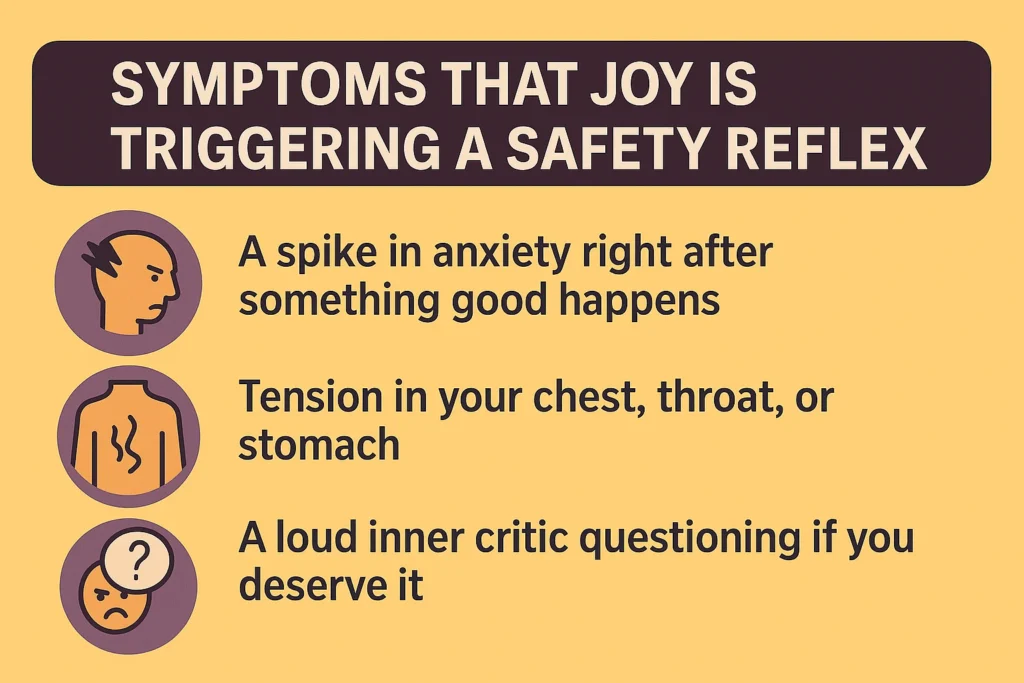Why Joy Feels Unsafe—And How to Make It Yours Again
“You don’t fear joy. You fear what came next.”

Why joy feels unsafe isn’t a metaphor—it’s a pattern your body learned. The moment happiness lands, your muscles tense. Breathing tightens. A silent alarm goes off in your system, hijacking what should feel like ease. To be clear, this isn’t dysfunction. It’s a brilliant adaptation your nervous system made to survive past pain. And now, it needs permission to feel differently.
✴️ When Joy Feels Unsafe, the Body Remembers
Let’s start here: your resistance to joy isn’t irrational. It’s learned.
If, at any point in your life, joy was followed by disappointment, disconnection, or even danger, your brain stored that pattern. It didn’t care if the happiness was short-lived or pure—it cared about what came after.
And so, joy became associated with:
- The grief that followed when the good thing didn’t last
- The vulnerability of letting your guard down
- The guilt of feeling good when others didn’t
- The shame of being seen in your wholeness
What feels like self-sabotage is often just self-protection with outdated instructions.
🔒 Why Joy Feels Unsafe to the Nervous System
Your nervous system has one job: keep you alive. Not keep you fulfilled. Not even happy. Just safe.
When joy comes in—especially if it arrives suddenly, or in overwhelming contrast to prolonged stress—your body reads it as a threat to your survival rhythm.
You’ve been trained for vigilance, not softness.
So when softness arrives? It feels suspicious.
Symptoms that Joy Is Triggering a Safety Reflex:
- A spike in anxiety right after something good happens
- Tension in your chest, throat, or stomach
- A loud inner critic questioning if you deserve it
- A pull to distract, downplay, or escape the moment

Joy becomes a high-frequency experience that your system hasn’t been taught how to metabolize.
🧠 Foreboding Joy: How and Why Joy Feels Unsafe After Trauma
When joy triggers anxiety instead of peace, it’s not random—it’s something called foreboding joy.
This happens when your system links happiness to loss.
You’ve probably heard it in your own mind:
- “This won’t last.”
- “Better not get too excited.”
- “Something always goes wrong when I let go.”
You might even sabotage joy on purpose to regain a false sense of control. Because if you cause the crash, at least you’re not blindsided.
And while this reflex was adaptive in trauma, it becomes invasive in healing. It blocks the very thing you’re trying to create: sustained capacity for aliveness.
💬 Search-Driven Reflections: (Real Questions, Real Patterns)
Here’s what people are really asking—and what their questions reveal:
“Why does being happy make me feel vulnerable?”
Because happiness requires surrender. And surrender, in trauma-wired systems, registers as exposure.
“Why does joy feel painful?”
Because joy can awaken buried grief. Sometimes the body weeps not out of sadness, but out of the shock of finally receiving.
“Why do I cry when I’m happy?”
Because joy disrupts our equilibrium. Crying is the body’s exhale—the parasympathetic system recalibrating from a surge of emotion.
“Why do I avoid good things?”
Because unfamiliar safety often feels more dangerous than familiar pain.
🛠️ How to Train Your Body to Trust Joy Again
This isn’t about mindset tricks.
This is about re-patterning a physiology that equates joy with threat.
🎧 Step 1: Interrupt the Reflex
When you feel joy rising and anxiety follows, name it:
“I feel the bracing. And I won’t punish myself for it.”
🌬️ Step 2: Breathe Lower, Not Harder
Deep breaths aren’t the point. Low, slow breaths through the nose trigger the vagus nerve and send a safety signal to your system.
Try: inhale 4 counts, exhale 6. Repeat until your shoulders drop half an inch.
🪞 Step 3: Create Micro-Moments of Joy That Are Easy to Digest
Instead of chasing big euphoric highs, build tolerance through:
- Morning sunlight on skin
- That song you secretly love at full volume
- A sip of something warm and slow
- Letting yourself laugh—even if it cracks you open a little
You don’t need to force joy.
You need to allow your body to survive it… until it no longer feels like a threat.
🔁 Rewiring Safety: Healing the Reflex Behind Why Joy Feels Unsafe
This isn’t about faking joy. And it’s definitely not about forcing “good vibes only.”
On the contrary—this is nervous system literacy.
It’s about understanding what safety feels like, and teaching your body that joy can belong.
Joy, when held with reverence, becomes a tool for rewiring your entire emotional framework.
Each time your system feels something good and doesn’t collapse, it creates a new map. A bridge from fear to presence. From hypervigilance to embodiment.
🧬 Consider This: Your Joy Isn’t Just for You
If you’ve been called “too sensitive,” or carry the emotional weight of generations—you might be what we call an emotional transmuter.
Meaning: when you learn how to feel joy safely, you don’t just rewrite your nervous system… you shift the emotional baseline for those around you.
Your healing becomes a template for others.
Especially in cultures or families where grief, guilt, or stoicism were standard.
🎯 Want Support in Healing Why Joy Feels Unsafe?
You don’t have to white-knuckle your way into joy.
You can train your nervous system to welcome it.
The Wired for Joy self-hypnosis track is a 20-minute audio experience designed to clear old trauma wiring and reprogram your brain to hold positive emotion—without fear of fallout.
It’s breath, tone, subconscious recoding—done gently.
You press play. The work happens.
And your body begins to believe: this gets to stay.
🪶 Closing Transmission: Let It Be Safe
You weren’t made to chase bliss until you collapse.
You were made to hold it.
And holding joy is an act of sacred defiance in a world addicted to bracing.
So next time joy rises and you feel that instinct to flinch—pause. Feel your feet. Touch your breath. And whisper:
“This is allowed. I am allowed.”
Joy may not need permission from the world.
But your body still does—from you.
✅Signal Note: Some links on this page are affiliate links. That means if you choose to purchase through them, I may earn a small commission—at no extra cost to you. I only share tools and frequencies I’ve personally tested in the loop. No nonsense. No false light. Just signal.


